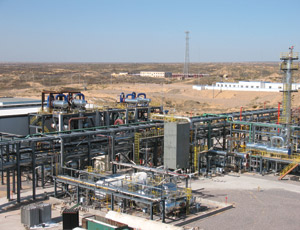To feed an insatiable need for more energy, countries worldwide are building terminals to import liquefied natural gas and constructing plants to convert waste fumes into LNG. However, the United States is no longer among that group.

In fact, the market for natural gas in North America has changed so dramatically in the past few years that companies that invested billions in terminals to import LNG now are looking to spend billions more to expand those facilities into export terminals.
Houston-based Freeport LNG, which in 2008 opened a $1-billion regasification facility in Freeport, Texas, has applied to the U.S. Dept. of Energy for permission to export LNG. Houston-based Cheniere Energy Inc. also has applied for an export LNG license for another $1-billion terminal, the three-year-old Sabine Pass LNG facility in Cameron Parish, La.
Timing proved poor for the terminals, which came on line just as discoveries and technological advances made it possible to extract huge amounts of natural gas from shale in the Marcellus, Haynesville and Eagleford fields.
In the last year alone, the amount of recoverable gas reserves has more than doubled, to 827 trillion cu ft in 2011 from an estimated 347 trillion cu ft in 2010, according to the U.S. Energy Information Administration. That volume accounts for enough gas to supply the U.S. for 100 years, according to Freeport LNG. The new gas discoveries drove down the cost of domestic natural gas, making it uneconomical to import LNG.
Freeport LNG has received a handful of LNG shipments, but only for storage, says Charles Reimer, president of Freeport LNG development. There is a growing market for the gas. According to the EIA International Energy Outlook, worldwide demand for natural gas is expected to rise 44% by 2035.
Freeport has paired up with Macquarie Energy to develop and market LNG created from the shale gas. Macquarie is one of the world’s largest marketers of natural gas. Reimer says it will cost about $2 billion to add the equipment required to clean up the gas from the pipeline and cool it down to -260°F.
The company hopes to receive approval from DOE and the Federal Energy Regulatory Commission by 2012 and have the facility operational by 2015. The proposed liquefaction facility would be capable of liquefying up to 1.4 billion cu ft of natural gas per day (Bcf/d). Freeport expects to select a contractor for the facility later this year.
Cheniere has selected San Francisco-based Bechtel, which built its gasification facility, to also build the liquefaction facility. Cheniere, which also must receive DOE and FERC approval, expects to be able to liquefy 1.2 Bcf/d by 2015.
Overseas, Overland Park, Kan.-based Black & Veatch continues to make inroads into the Asian market. The company recently received a contract to build three new small LNG liquefaction plants in China, bringing the total number of LNG facilities B&V is building there to 11. The firm won all but four contracts it bid.
The projects take the hydrocarbon gas generated from industrial coke ovens, clean it and then turn it into LNG, which is used for industrial purposes or as fuel for vehicles. Before the projects, the emissions were simply vented into the air. Each facility produces about 35 million cu ft of LNG a day.
Price said China’s drive to turn the emissions into LNG is driven by the desire to clean up the environment.
“They pay for value,” says Brian Price, vice president and LNG technology manager for Black & Veatch. The proprietary design of the plant is “elegantly simple,” he says.
One of its first plants was fully operational three weeks after it was complete. A competitor took a year to get its plant started up, Price notes.
Each project, which looks like a mini-refinery with storage capabilities, cost about $70 million to build, he says.
Black and Veatch also is working on two or three other medium-sized LNG projects, including a floating LNG barge.
“It’s quite an active time,” Price says.

Post a comment to this article
Report Abusive Comment